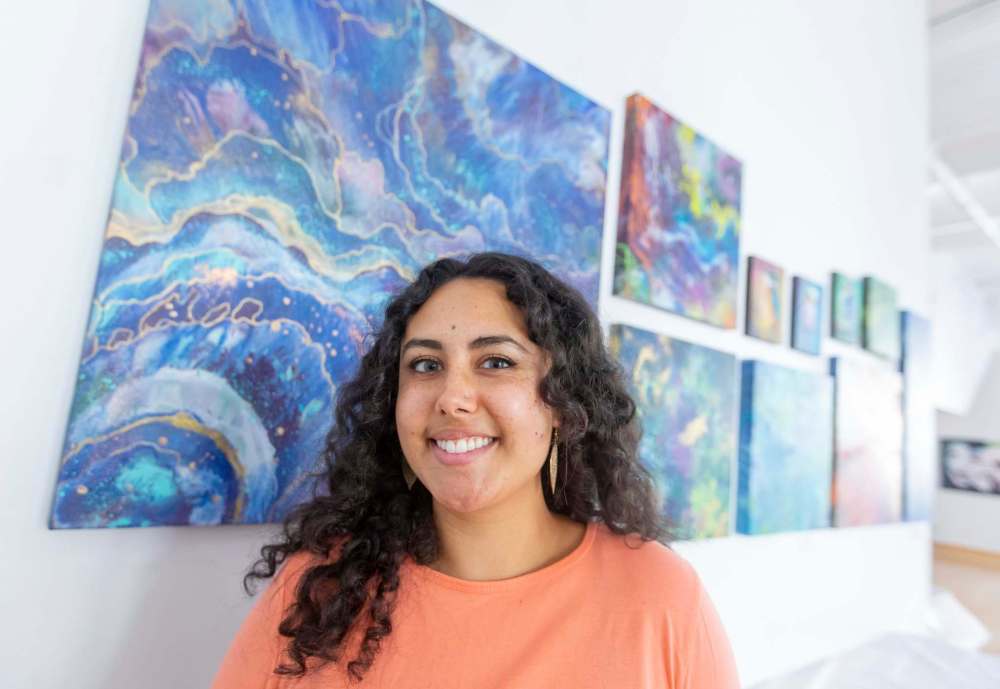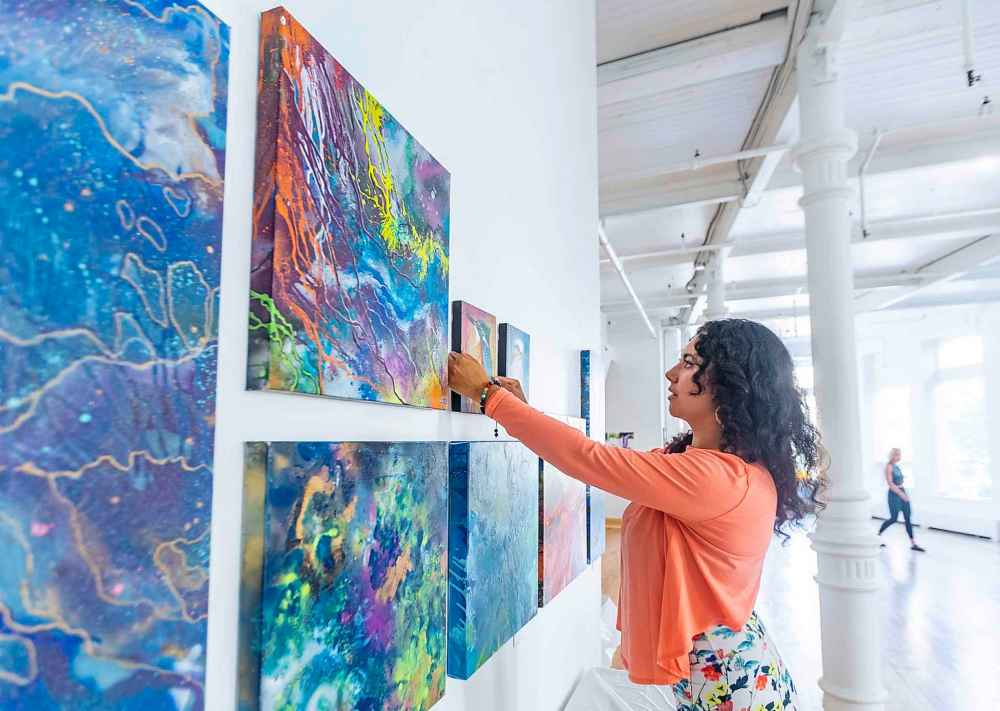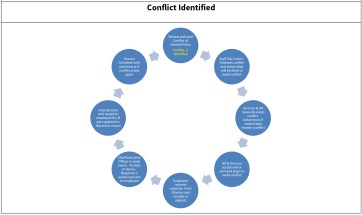She speaks colour Winnipeg artist Talia Keyton among small percentage of people whose brains are wired to link words, letters and numbers with specific hues, something she translates in her work
Read this article for free:
or
Already have an account? Log in here »
To continue reading, please subscribe:
Monthly Digital Subscription
$0 for the first 4 weeks*
- Enjoy unlimited reading on winnipegfreepress.com
- Read the E-Edition, our digital replica newspaper
- Access News Break, our award-winning app
- Play interactive puzzles
*No charge for 4 weeks then price increases to the regular rate of $19.00 plus GST every four weeks. Offer available to new and qualified returning subscribers only. Cancel any time.
Monthly Digital Subscription
$4.75/week*
- Enjoy unlimited reading on winnipegfreepress.com
- Read the E-Edition, our digital replica newspaper
- Access News Break, our award-winning app
- Play interactive puzzles
*Billed as $19 plus GST every four weeks. Cancel any time.
To continue reading, please subscribe:
Add Free Press access to your Brandon Sun subscription for only an additional
$1 for the first 4 weeks*
*Your next subscription payment will increase by $1.00 and you will be charged $16.99 plus GST for four weeks. After four weeks, your payment will increase to $23.99 plus GST every four weeks.
Read unlimited articles for free today:
or
Already have an account? Log in here »
Hey there, time traveller!
This article was published 01/08/2019 (2322 days ago), so information in it may no longer be current.
Talia Keyton sees colours in words.
Art Preview
Synesthesia and the Natural World
by Talia Keyton
● Fleet Galleries, 65 Albert St.
● Aug. 1-13; part of First Fridays in the Exchange on Aug. 2
● Monday-Friday, 9 a.m.-4:30 p.m.; Saturdays, 10:30 a.m.-2:30 p.m.
● Artist reception Aug. 8, 1-8 p.m.
● Free admission
A visual artist originally from the United Kingdom, Keyton has had a lifelong interest in human perception, stemming from her own experience living with synesthesia.

“Synesthesia is a neurological phenomenon in which the stimulation of one sensory or cognitive pathway leads to automatic, involuntary experiences in a second sensory or cognitive neurological pathway,” she explains.
Keyton further elaborates on her own particular case of grapheme-colour synesthesia — the most common of more than 60 variants — adding that, for her, “written words, individual letters and numbers are all inherently coloured.”
Synesthesia is not an unheard of phenomenon in the creative world. Lolita author Vladimir Nabokov had the same variant of synesthesia as Keyton and often attempted to communicate his interior experience.
“Oatmeal n, noodle-limp l, and the ivory-backed hand mirror of o take care of the whites,” he wrote in his autobiography Speak, Memory. “I see q as browner than k, while s is not the light blue of c, but a curious mixture of azure and mother-of-pearl.”
Research has revealed that between two and four per cent of the general population naturally experience synesthesia, but it’s believed that the phenomenon is seven times more common in artists, poets and novelists.
Clearly, Keyton is in good creative company.
But life — and art — as a synesthetic isn’t easy. It can be difficult for Keyton to explain to a non-synesthetic exactly what she sees and, unlike Nabokov, she finds that words often fail her.
“My synesthetic pieces all start with a word, and a desire to capture the surrounding sensations I experience in their purest form,” she says. “It can be like describing the indescribable, at times. Details are frequently mistranslated, and frustration is always lurking around the corner demanding a bite of my resolve. Nevertheless, even an 80 per cent accurate execution of what’s within my mind’s eye I find to be quite satisfying and always worth the struggle.
“Each of my synesthetic pieces is an attempt at a clearer translation.”
She describes her creative process as a similar struggle: “I am ripping instinct out of my brain and into the real of physicality.”
Keyton took an interest in art at a young age. “I have been drawing ever since I was large enough to wield a pencil, and painting not long after.” She enjoys experimenting in a variety of mediums, but favours spray paint and acrylic.
“I love acrylic because it is satisfying to spread smooth, brightly coloured butter onto a white canvas. I enjoy spray paint, mainly because of the speed it exits the can; for this reason the first two layers of my work usually involves spray paint.”
There’s an instinctual drive for Keyton behind the process of working in these mediums: “The incredibly short dry-time forces me to work quickly, which allows my logical/rational mind to take back seat while my gut instincts drive the process.”
Keyton, as might be expected, considers colour to be a priority in her work.
“Colour is my friend. I enjoy using unlikely combinations to convey a certain atmosphere or ambiance,” she says. “I use intense colour, pattern repetition and textural change to portray emotion in my work.”
Keyton moved to Canada with her family in 2007 and wound up in Winnipeg by accident.

“I fell in love with this city’s unique charm and the incredible people,” she says. “We put down roots and haven’t looked back since.”
A recent graduate of the environmental design program at the University of Manitoba, she took a leap of faith and decided to try her hand at a career as an artist.
“My true passion is painting,” she says. “Life is just too short not to do the things we love.”
Nevertheless, she has found a way to combine her passions with her education; nature and the environment is the focus of her upcoming exhibition, Synesthesia and the Natural World, running Aug. 1-13 at Fleet Galleries in the Exchange District. The exhibition is also a part of First Fridays in the Exchange on Aug. 2.
The natural world is a fascinating subject for Keyton, who is enamoured with the intimate and intricate relationship between nature and humanity.
“Living organisms in the natural world have always captured my attention. Expression of life, in general, and all the different ways that life can manifest — in endless possibilities of colours, sounds and shapes — will never cease to inspire me.”
Keyton has already had her artwork presented at numerous local galleries and internationally, including at the Conception Art Show in Phoenix and in New York. Her most recent exhibit, In Honour of Trees, took place earlier this year in Winnipeg at the Wayne Arthur Gallery.
Although still a fairly fresh on the local visual-arts scene, it looks like the risk Keyton took to pursue a career as a full-time artist is paying off.
More information about Talia Keyton and her artistic work is available at her website, www.tkkeyton.com.
frances.koncan@freepress.mb.ca
Twitter: @franceskoncan

Frances Koncan (she/her) is a writer, theatre director, and failed musician of mixed Anishinaabe and Slovene descent. Originally from Couchiching First Nation, she is now based in Treaty 1 Territory right here in Winnipeg, Manitoba.
Our newsroom depends on a growing audience of readers to power our journalism. If you are not a paid reader, please consider becoming a subscriber.
Our newsroom depends on its audience of readers to power our journalism. Thank you for your support.











